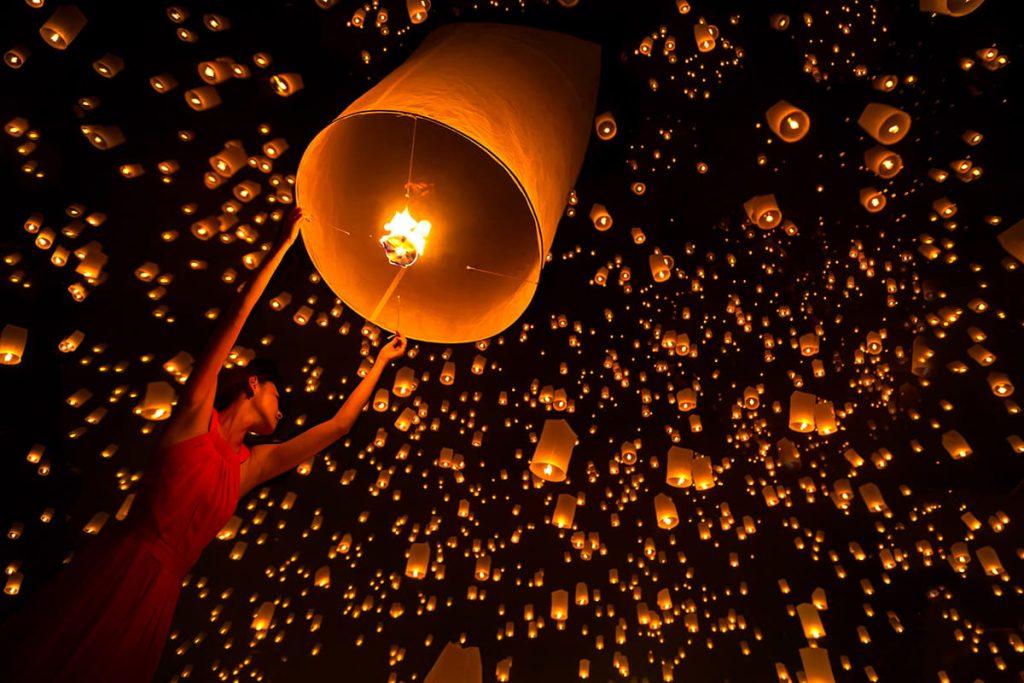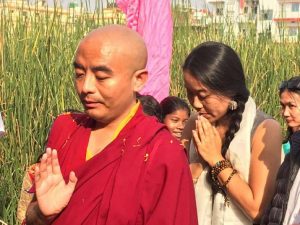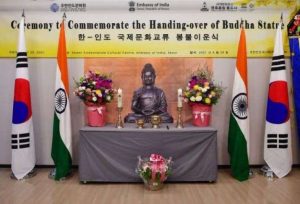The three-month rains retreat of Vassavasa has been a mainstay tradition of monastic communities since the founding of the Buddhist order. However, its conclusion, Pavarana, is an important event in itself, typically falling on the full moon of the 11th lunar month. In 2022, the festival was celebrated on 9 October.
Pavarana means “inviting admonition.” This refers to inviting one’s fellow monks to offer reprimands for any offenses or misdeeds committed during the three-month retreat when monks lived communally. According to the Buddhist teaching, this practice helps to ensure fidelity to the Vinaya, the monastic code of personal conduct. Pavarana is followed by the Kathina robe-offering ceremony, which continues until the full moon of the 12th lunar month.
Theravada Buddhists throughout the world observe Pavarana by performing meritorious acts traditionally associated with the festival. In the morning, laypeople gather in monasteries to observe five or eight precepts for the day. Before noon, there is a lengthy period of chanting during which food, flowers, incense, lamps, and other offerings are made in homage to the Buddha, the Dhamma, and the Sangha. Then the devotees serve meals to the monks and eat whatever is left over. In the afternoon, the monks give Dhamma talks followed by discussions on the importance of the festival. The ceremony is concluded by sharing the accumulated merits with family members and all sentient beings.
In some Theravada Buddhist societies, including Bangladesh and Thailand, the evening following the Pavarana ceremony is marked by festivities. Devotees launch sky lanterns—hot-air balloons made of paper with a small flame burning at the center—known as fanush in Bangladesh and khom fai in Thailand. In Bangladesh, evening festivals often attract hundreds of people, including those of other faiths, in a show of religious harmony.
Sky lanterns have long been used in Chinese and Thai celebrations, and were also a vital part of communication in ancient China as they were occasionally used to send messages across long distances. In China, light is a symbol of harmony and tranquillity, and lanterns occupy an important cultural position to this day. However, using lanterns for celebrations such as weddings, birthdays, music festivals, national holidays, and so on has also been popular around the world throughout history.
The Buddha-Dharma Center of Hong Kong likewise celebrated Pavarana this year. Many Buddhists from Bangladesh, Sri Lanka, and Hong Kong took part in the celebration and performed meritorious acts. Along with my family, I observed the Five Precepts, worshipped the Buddha, the Dhamma, and the Sangha, and offered food and other essentials to the monks. In his speech to the assembled Buddhists, Venerable Professor K. L. Dhammajoti spoke in depth about the importance of Pavarana. He commended Bangladeshi and Sri Lankan Buddhists in particular for upholding their Buddhist heritage and culture in Hong Kong. To ensure that everyone from Bangladesh and Sri Lanka could appreciate the significance of the occasion, two monks from Bangladesh and Sri Lanka give Dhamma talks in their respective languages. The monks had lunch after the ceremony, and we all ate together thereafter, with the meal becoming a social gathering.
When I lived in Bangladesh, I also made sky lanterns to commemorate Pavarana. Making lanterns involves building artistic structures out of bamboo and applying colored paper to create a variety of designs. However, no holes can be made in the lantern. Afterwards, a light fabric saturated in wax is tied to a wheel of thread that has been made for the lantern.
When lantern is lit, it produces a good deal of heat over time, and the lantern eventually rises upward, drifting toward the sky. The sky can be illuminated by the glow from large groups of lanterns for a long time, providing festival-goers with quite the spectacle. But what happens to the fire within these airborne lanterns? The original pioneers of this festival took into account the potential fire hazard by incorporating a built-in solution. When the burning cloth is exhausted, it turns to ash and the flying lanterns drop back to the ground. There are no hot embers carried in the wind. This makes the ritual relatively safe compared to other lantern rites.
According to Theravada Buddhist legend, Prince Siddhartha, determined to attain liberation from suffering, renounced the household life on the auspicious full moon of Asadha (Pali: Asalha), a month that corresponds with June or July in the Gregorian calendar. Siddhartha traveled to the river Anoma with his charioteer Chandaka and horse Kanthaka. Leaving them both behind, he journeyed into the woods and changed into a mendicant’s robes. Before becoming a wandering sramana, Siddhartha cut his hair with his sword. He resolved to himself: “If the perfection to become a Buddha remains within me, may this tuft of hair thrown upwards not fall to the ground but remain in the sky.” With this vow of determination, he threw the lock of hair upward. Surprisingly, not a single hair fell to the ground.
Tradition says that King Indra of the deva realm (a heavenly plane associated with good rebirth but also sensual pleasures) kept the Buddha’s hair in a gem-studded gold pot. Indra took the hair to his home of the Tavatimsa Heaven. The chaitya in which this hair relic was placed was called the Chulamani Chaitya. Buddhists believe that the gods of Tavatimsa still worship the Chulamani Chaitya. But human worshippers cannot ascend to the deva realm to worship the Buddha’s hair. So instead they light paper lanterns, and on Pavarana they send the sky lanterns upward to worship the Chulamani Chaitya. The lanterns are released to the chant of “sadhu, sadhu, sadhu” from the monks echoing into the night. Then, by reciting prayers, sutta passages, and mantras, Buddhists, who will often be barefoot during this occasion, offer obeisance to the Chulamani Chaitya.
Lanterns are supposed to be lit on the full moon of Asadha, when the skies are clear. But due to possible rain or cloudy skies, there might not always be the right opportunity to fly the lanterns.
It is unknown exactly when Pavarana and its ritualistic processes became associated with the lanterns. However, what is certain is that it is a skill that has been passed down from generation to generation for centuries. Looking back, incidents of fires due to improperly made lanterns have been rare because the rope or cloth contains the flame so well that the lantern only descends when the fire is extinguished.
Nowadays, many people in different countries, regardless of religion, have unwittingly undermined the solemn custom of making lanterns, entrusting their production to unskilled hands. At the same time, low-quality lanterns are available in the open market which do not fly properly or fly without the proper mechanisms for self-extinguishing, potentially causing serious accidents.
There are often also no regulations to determine where people or groups may launch lanterns into the air, resulting in safety problems. As a result, many countries in Asia have tightened regulations around this custom. In some cases, lanterns have become prohibited altogether, including in Bangladesh. During the solar New Year Festival, unfortunate accidents involving flying lanterns have occurred in parts of the country, and so they have been prohibited at any time other than Pavarana. Similarly, due to fire-safety concerns, the US state of Washington outlawed their use in 2015.
Many Buddhists agree that it is time to consider whether it is necessary to give flight to hundreds of lanterns for traditional festivals. Although it is always a joy to launch lanterns, there are also risks. Buddhist communities are apprehensive of the fire risks posed, even though they continue to celebrate the launch of sky lanterns as a part of traditional Bangladeshi and Thai culture.
Related features from BDG
The Khao Phansa Festival: The “Buddhist Lent” of Thailand
Sky Lanterns and Walubi: My Waisak Day at Borobudur in 2018, Part 1
Sky Lanterns and Walubi: My Waisak Day at Borobudur in 2018, Part 2
Art, Culture, and Healing the World: A Conversation with Haema Sivanesan
A Journey Through 5,000 Years of Tibetan History and Culture at the Capital Museum in Beijing
Related news from BDG
Buddhism in Barcelona: The First Buddhist Film Festival in Catalonia
International Buddhist Confederation Hosts Abhidhamma Day Conference in Noida, India














